Ceramic glass offers exceptional heat resistance and durability, making it ideal for cookware and high-temperature applications. Crystal glass, known for its clarity and brilliance, is preferred for fine glassware and decorative items due to its ability to refract light beautifully. While ceramic glass emphasizes functionality and toughness, crystal glass prioritizes aesthetic appeal and craftsmanship.
Table of Comparison
| Feature | Ceramic Glass | Crystal Glass |
|---|---|---|
| Material Composition | Aluminum oxide-based ceramic | Lead or lead-free silica-based glass |
| Durability | Highly scratch and heat resistant | Fragile, prone to chipping |
| Transparency | Opaque to translucent | Highly transparent and brilliant |
| Weight | Lightweight | Heavier due to dense crystal structure |
| Use Cases | Cooktops, protective panels | Drinkware, decorative items |
| Cost | Moderate | Higher price range |
Introduction to Ceramic Glass and Crystal Glass
Ceramic glass is a durable, heat-resistant material commonly used in cooktops and fireplaces, known for its ability to withstand rapid temperature changes without cracking. Crystal glass, made from silica combined with lead or other metal oxides, exhibits exceptional clarity and brilliance, making it ideal for fine glassware and decorative items. Both materials serve distinct purposes, with ceramic glass prioritizing thermal resistance and crystal glass emphasizing aesthetic elegance.
Composition and Manufacturing Processes
Ceramic glass is composed mainly of crystalline and amorphous materials, typically including silica, alumina, and various metal oxides, which undergo high-temperature fusion to form a heat-resistant, non-porous surface. Crystal glass, often containing lead oxide or barium oxide, is manufactured by melting raw materials followed by controlled cooling and hand or machine cutting to enhance clarity and refractive index. The manufacturing process of ceramic glass involves rapid cooling to stabilize its structure, while crystal glass requires slower annealing to develop its characteristic brilliance and resonance.
Key Differences in Material Properties
Ceramic glass is composed of crystalline and non-crystalline materials with high heat resistance and thermal shock durability, while crystal glass contains lead oxide or other metal oxides, enhancing its brilliance and density. Ceramic glass is typically harder and more scratch-resistant, suited for cookware and protective surfaces, whereas crystal glass is softer but offers superior clarity and refractive qualities, ideal for fine glassware and decorative items. The thermal insulation properties of ceramic glass contrast sharply with the enhanced acoustics and aesthetic appeal found in crystal glass due to its molecular structure.
Visual Appearance and Transparency
Ceramic glass exhibits a matte, opaque finish with reduced transparency due to its crystalline microstructure, offering a more muted and diffused light transmission. Crystal glass boasts exceptional clarity and high transparency, characterized by its brilliant sparkle and refractive qualities resulting from lead or other metal additives. The distinct visual appearance of ceramic glass tends toward a frosted and textured look, whereas crystal glass provides a clear, glossy surface that enhances visual depth and brilliance.
Durability and Strength Comparison
Ceramic glass exhibits superior durability and heat resistance compared to crystal glass, making it ideal for high-temperature applications like cooktops and fire-resistant panels. Crystal glass, while prized for its clarity and brilliance, tends to be more fragile and prone to chipping or cracking under impact or sudden temperature changes. The structural composition of ceramic glass, which includes reinforced materials, grants it higher strength and longevity than the lead oxide-based crystal glass typically used in decorative or tableware items.
Heat Resistance: Ceramic Glass vs Crystal Glass
Ceramic glass exhibits superior heat resistance, withstanding temperatures up to 1000degC without deforming or cracking, making it ideal for applications involving direct heat exposure. In contrast, crystal glass generally tolerates temperatures up to around 250degC before thermal stress causes damage, limiting its use in high-temperature environments. The inherent heat stability of ceramic glass results from its non-crystalline, tempered structure, whereas crystal glass's lead content and crystalline lattice contribute to its lower thermal threshold.
Common Uses in Household Products
Ceramic glass is commonly used in household products such as oven doors, stovetops, and cooktops due to its high heat resistance and durability. Crystal glass is favored for decorative items like wine glasses, vases, and chandeliers because of its clarity, brilliance, and ability to be finely cut. Both materials serve distinct purposes, with ceramic glass excelling in functionality and crystal glass prized for aesthetic appeal.
Maintenance and Cleaning Requirements
Ceramic glass demonstrates high resistance to scratches and thermal shock, requiring minimal maintenance with gentle cleaning using non-abrasive cloths and mild detergents. Crystal glass, being more delicate and prone to chipping, demands careful handwashing with soft sponges and avoidance of harsh chemicals to maintain its clarity and brilliance. Regular polishing is recommended for crystal glass to prevent dullness, while ceramic glass's durability allows for easier and less frequent cleaning routines.
Environmental Impact and Sustainability
Ceramic glass offers superior environmental benefits compared to crystal glass due to its energy-efficient production process and recyclability. Unlike crystal glass, which often contains lead and other heavy metals harmful to ecosystems, ceramic glass is typically lead-free and non-toxic, reducing its ecological footprint. The durability and longer lifespan of ceramic glass contribute to sustainability by minimizing waste and the need for frequent replacements.
Choosing the Right Glass for Your Needs
Ceramic glass offers exceptional heat resistance and durability, making it ideal for cookware and oven doors, while crystal glass is prized for its clarity, brilliance, and decorative appeal, perfect for fine dining and display pieces. Selecting the right glass depends on the intended use: ceramic glass suits high-temperature applications and durability requirements, whereas crystal glass excels in aesthetic presentation and light refraction. Consider factors such as thermal resistance, strength, and visual properties to ensure the glass meets your functional and stylistic needs.
Ceramic glass vs Crystal glass Infographic

 materialdif.com
materialdif.com